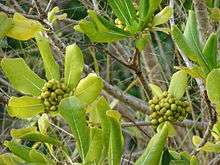Pittosporum viridiflorum
Pittosporum viridiflorum (Cape cheesewood,[1] Afrikaans: Kasuur, Sotho: Kgalagangwe, Xhosa: Umkhwenkwe, Zulu: Umfusamvu) is a protected tree in South Africa.[2]
| Pittosporum viridiflorum | |
|---|---|
 | |
| Scientific classification | |
| Kingdom: | Plantae |
| Clade: | Tracheophytes |
| Clade: | Angiosperms |
| Clade: | Eudicots |
| Clade: | Asterids |
| Order: | Apiales |
| Family: | Pittosporaceae |
| Genus: | Pittosporum |
| Species: | P. viridiflorum |
| Binomial name | |
| Pittosporum viridiflorum Sims | |
Morphology
The leaves are obovate with margin entire and wavy, conspicuous net veining, crowded at ends of branches. Often with a single mis-formed leaf. The midrib has a yellow colour and the leaf has a brilliant green colour when viewed against the light. Fruit borne in clusters at the end of branches, yellow becoming brown, dehiscent with four bright red seeds covered with a sticky exudate with a faintly sweet smell. The bark has brown lenticels.
gollark: > Which is probably never
gollark: I'm not going to use any of that stuff until software security is good enough that people won't be able to hack your brain. Which is probably never.
gollark: Who's going to put a .exe file in /boot specified in autorun.inf before they run the updater once?
gollark: You could do both. Automatically delete the current dumb malware on first run, detect weird stuff afterward.
gollark: Did people just ignore the security implications or something?
See also
- List of Southern African indigenous trees
External links
References
- "Pittosporum viridiflorum". Natural Resources Conservation Service PLANTS Database. USDA. Retrieved 6 October 2015.
- "Protected Trees" (PDF). Department of Water Affairs and Forestry, Republic of South Africa. 3 May 2013. Archived from the original (PDF) on 5 July 2010.
This article is issued from Wikipedia. The text is licensed under Creative Commons - Attribution - Sharealike. Additional terms may apply for the media files.